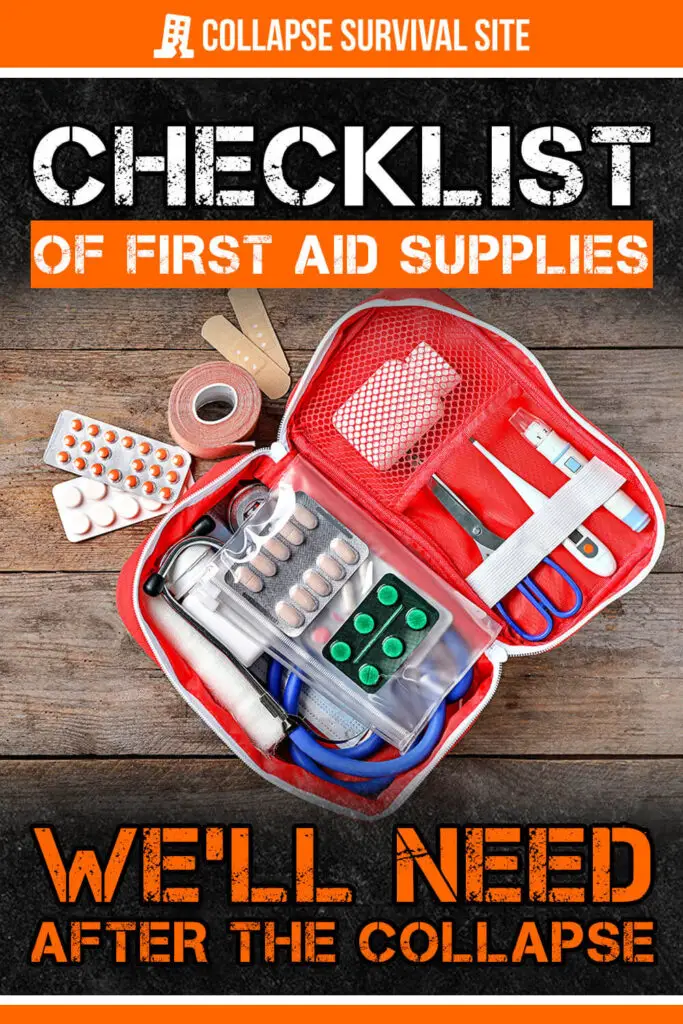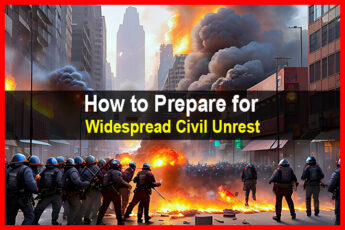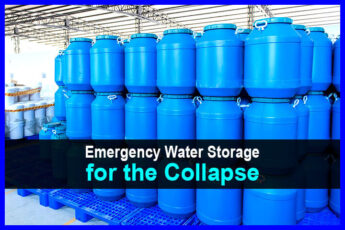Estimated reading time: 15 minutes
When society collapses, all the systems that sustain our lives will unravel. Essential services, supplies, businesses, and organizations that we depend on will disappear, leading to a breakdown of societal norms. Basic necessities will be scarce, and the risk of starvation, injury, illness, and disease will skyrocket.
Amidst all the chaos, conventional medical services will be particularly hard-hit. Hospitals and clinics will find themselves overwhelmed with patients and dwindling supplies. The lack of medications, medical equipment, and skilled professionals will make lead to ever-higher mortality rates.
As we contemplate such a future, we also need to consider alternative strategies for health care. Building a comprehensive stockpile of first aid supplies is imperative for survival in a doomsday scenario. This article lists and describes all the medical resources you need to gather now, while you still can.
Want to save this post for later? Click Here to Pin It On Pinterest!
- It’s Happened Before
- Emergency Medical Considerations
- First Aid Kits
- Burn Kits
- Additional First Aid Supplies
- Medical and First Aid Tools and Equipment
- Treatment of Conditions Based on Level of Emergency
- The OTC Medicine Chest
- What About Prescription Pharmaceuticals
- A Medical Library
- Apps
- Skills You Should Learn and Practice
- Alternative Medical Treatments
- Where to Start
It’s Happened Before
Look at the pages of history covering any war, anywhere, and the inability of the hospitals and doctors to treat everyone becomes obvious. What emerges is a “triage” decision making process where only the most severely ill or injured receive treatment, and that will depend on their survivability potential. If it will take too many resources to save someone, they are not treated. That’s the cold reality of triage.
Closer to home is the experience we endured with the COVID-19 pandemic. At the height of infections during 2020, patients in hospitals were lined up in hallways on gurneys and even hospital morgues were overwhelmed.
And it’s not over. As we begin 2023, respiratory diseases have combined to infect people with COVID-19, RSV, and surging cases of the flu. Once again the hospitals are filling up, and even some pharmacies are reporting shortage of prescription medications.
What becomes apparent is that any significant event or combination of events resulting in a collapse of society will make everything difficult and, in many instances, life threatening.
Emergency Medical Considerations
We’re going to cover a checklist of first aid supplies you should have on hand, but keep in mind that there’s more to medical treatment than piles of bandages and pill bottles.
That’s why we’ll also cover books on various medical subjects, online courses, and some natural remedies to learn about and have on hand if and when your stockpile runs out.

First Aid Kits
One of the fastest solutions to preparing for medical emergencies is a pre-packed first aid kit. But there’s a catch. A standard kitchen first aid kit that can treat simple cuts and burns will be far outmatched by the challenges of a societal collapse.
If you have a kitchen first aid kit, that’s great, but don’t stop there. Think about serious expedition level kits or trauma kits. In most instances they have the supplies and equipment to deal with a wide range of significant and severe medical emergencies.
MobileAid-First-Responder-Trauma-Kit
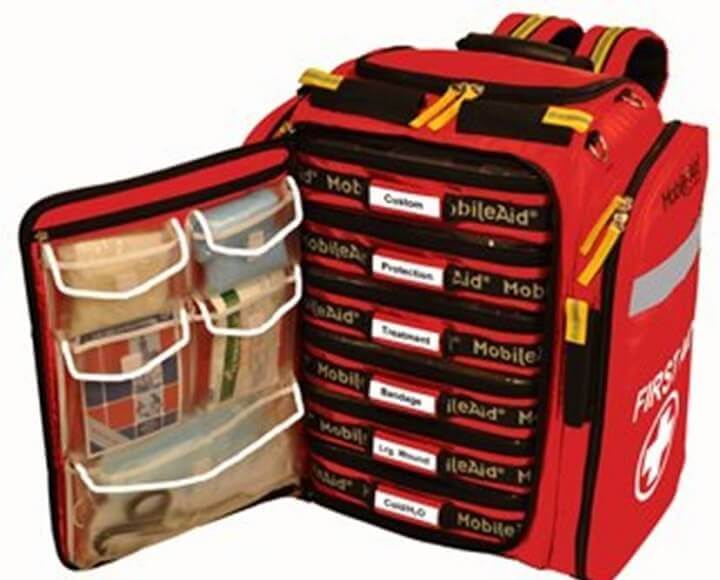
The word “mobile” is important. A bug out is always a possibility during and after a collapse, and having a pre-packed kit that is easy to transport and access makes sense. It works fine at home, but it’s a quick grab and go option as well.
This kit is a standard pack in many EMT ambulances and covers a broad range of treatments. It’s largely designed to treat injuries rather than illnesses or disease.
Lightning-Jumbo-First Responder-Trauma-Kit
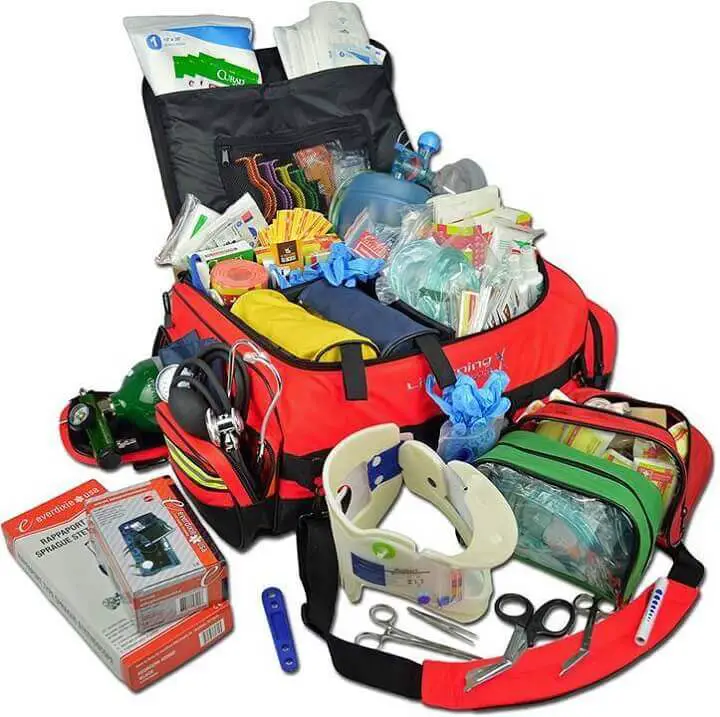
This kit essentially covers every medical emergency a paramedic could confront. It has a variety of OTC medications for pain and bleeding, but here again it’s largely designed to treat injuries following an emergency rather than disease or chronic illness.
Military Field First Aid Kit
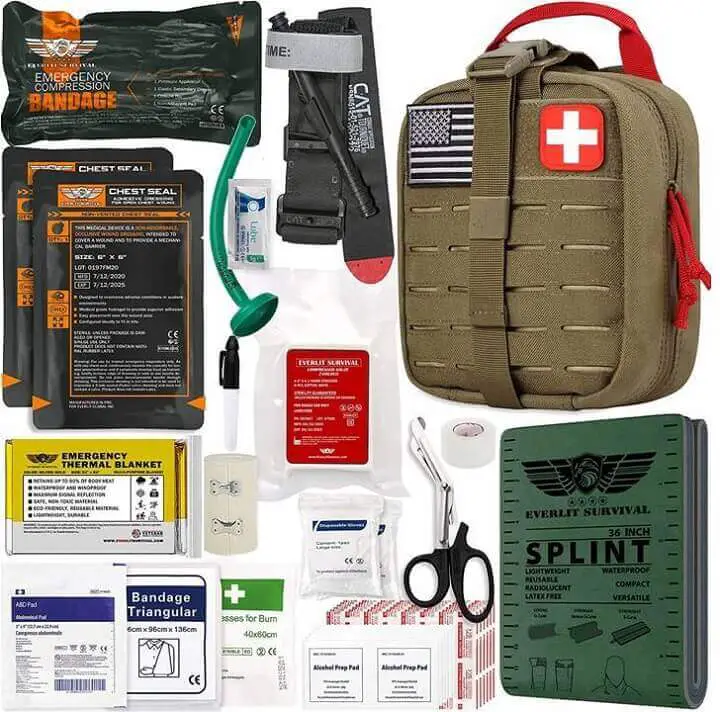
If you feel you may be in a bug out situation then, depending on your location, you will be better served with a portable kit that has basic trauma gear but is compact and easy to transport.
A lot depends on how you’re bugging out, but space is always limited when bugging out (especially if you’re on foot) so portability is a necessary option.
Burn Kits

Burns require special treatment including burn gels and burn bandages. This kit has the basics, but it’s only enough to treat one major burn. We’ll cover additional supplies to supplement any burn kit, but this is a good place to start.
Specialized Wound Care
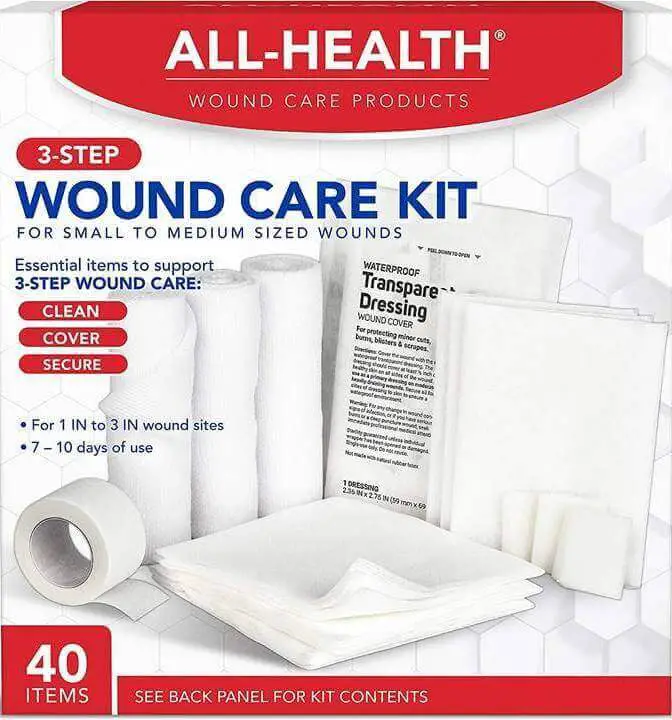
Deep wounds can happen a variety of ways, from everyday injuries caused by falling structures or debris to gunshot wounds. This kit only supplies large application dressings, but a tourniquet offered in other kits or one you improvise may be critical.
Suture Kit

Deep wounds require sutures, although a butterfly bandage can work in an emergency. What’s critical is to not only have a suture kit but to practice suturing either on a rubberized practice mat or even a large piece of raw pigskin.
Additional First Aid Supplies
An unfortunate reality is that supplies of anything run out over time. It’s also true that many first aid kits offer a minimal supply for one or two treatments. There are always plenty of little bandages, but more serious applications like large gauze pads and burn gels only show up once or twice.
Given that stores will most likely be closed after a collapse and that shelves will be empty as a result of hoarding or looting, you might want to think ahead. It’s nice to believe first aid kits will always solve a medical emergency, but if the amount of anything in a first aid kit is minimal, you'll have to add to the inventory.
Here are some basics to consider as a supplement or in addition to the supplies in a pre-packed first aid kit:
- Ace bandage variety
- Anti-itch creams and ointments
- Antiseptic Ointments and Creams
- Arm and leg splints
- Bleed stop powder
- Butterfly bandages
- Cold compresses
- Cotton balls
- Cotton swabs
- Dental first aid kit
- Eye first aid kit
- Eye pads
- Finger splints
- Gauze pads in assorted sizes
- Gauze rolls
- Hand sanitizer
- Multivitamins
- Sterile saline solution
- Surgical tape rolls
- Trauma bandages
- Wound care Super Glue
- Wrist and ankle braces
The amount of each item depends on the number of people in your group, the duration of the crisis, and your budget. There are some options for first aid supplies at the dollar store you should consider as well.
Medical and First Aid Tools and Equipment
If you’re buying one of the advanced trauma first aid kits, you'll find that many of the medical tools and equipment you need are already supplied. But you may be missing some things, like surgical gloves which are only intended for one-time use.
Here are some additional tools and equipment to think about, especially if you choose not to buy a complete trauma kit.
- Blood pressure cuff
- Dental tools
- Glucose monitor
- Magnifying glass
- Medical stapler and staple remover
- Medical thermometer
- Mylar emergency blankets
- Oxygen meter
- Safety pins
- Sterilized surgical gloves
- Surgical scissors
- Tourniquet
Treatment of Conditions Based on Level of Emergency
Much of what we’ve covered so far is a general list for various possibilities. In an effort to cover every possibility, we’re going to try to isolate medical emergencies based on the patient’s condition. It will give you a benchmark for what you might need and need to know in the event of a specific medical emergency rather than just filling boxes and shelves with medical “stuff.”
Understanding the Levels
LEVEL 1
These are conditions that many of us encounter and treat at home on a regular basis. They rarely require a doctor visit or prescription medications and are easily treated with OTC medicines and medical supplies bought off the shelf at a pharmacy.
LEVEL 2
These conditions are a bit more serious, and while some of us can deal with them at home, many people consider a visit to a convenient care facility or doctor’s office. On rare occasions, they require a visit to the emergency room depending on the age and general physical condition of the person.
LEVEL 3
These are serious medical conditions and would typically be treated at an emergency room or in a doctor’s office. In desperate times, if there is no access to medical facilities or medical professionals, it’s best to be prepared for the worst—not only with the right equipment and supplies, but the knowledge of how to treat the condition. This begins to get into areas that require significant research on how to treat these conditions.
LEVEL 4
These are critical medical emergencies and would be traditionally treated by paramedics arriving in an ambulance or at a hospital emergency room or urgent care facility. To some degree, there may be little anyone can do without sufficient medical training and sophisticated facilities.
We’re covered a few conditions, but if you want insight and advice on how to treat a heart attack, stroke, or broken neck at home, you should probably take a close look at the reference resources we’ve linked to at the end of this article. No guarantees on good solutions, but at least some clues, insight, and some hope.
Approaching the Conditions
There are also some general comments in the graph on approaching any condition. Here’s how to think about them:
APPARENT SYMPTOMS
These are very general symptoms that sometimes appear singly, together, or not at all. Your best approach to evaluating any symptom is to ask yourself or the person, “What do you feel?” If they’re not sure, some of these symptoms might give you a clue.
EQUIPMENT NEEDED FOR CONTINUOUS TREATMENT
Think wheel chair or crutches. These are long-term things that an individual may need for a period of time or that you use over and over again.
SUPPLIES NEEDED FOR IMMEDIATE TREATMENT
This is what you want to have on hand when you first encounter a medical situation. It’s the stuff that will allow you to immediately begin to treat the condition and to some degree offer immediate relief to the person you’re treating. Don’t assume this is a one-time use. Others in your family or group my encounter similar problems, and some individuals may need repeated treatment.
MEDS POSSIBLY NEEDED FOR TREATMENT
This is a tough one. Few of us are pharmacists or doctors, and prescription meds are dependent on a highly complex group of organizations, laws, manufacturers, and a distribution system. They’re also dependent on what the name implies: “a prescription.”
Whether you decide to keep your leftover family prescriptions or consider alternative resources like veterinary suppliers, that’s once again up to you. However, you should not be shy about stockpiling a good amount of OTC meds from your local pharmacy or grocery store.
| Level 1 Condition | Apparent Symptoms | Equipment for Continuous Treatment | Supplies for Immediate Treatment | Meds Possibly Needed for Treatment |
|---|---|---|---|---|
| Sprain | Pain, swelling, redness | Refillable ice bag, elastic bandages for support, cane or crutches | Ice for ice bag or reusable cold-packs for immediate relief | OTC pain relievers like Benadryl to reduce swelling, topical ointment for muscles |
| Shallow cut | Minor bleeding | N/A | Antiseptic wipes, assorted bandages | Triple antibiotic ointment |
| 1st degree burn | Redness, blistering | N/A | Ice for immediate relief or cold water, Bandages | Topical pain relief spray, triple antibiotic ointment with topical pain relief |
| Painful insect bite including bees, wasps, hornets, fire ants and non-poisonous spiders | Localized pain and swelling | Refillable ice bag | Ice for the ice bag for immediate relief | Topical pain relief spray, baking soda |
| Coughing and congestion | Sneezing and coughing | Humidifier or tea kettle | Water for steam from humidity | Cough medicine, vaporub, |
| Fever due to cold or flu | Temperature of 100° F. up to 102.5 | Thermometer, refillable ice bag, washcloths | Ice for bag, cold water for cloths for immediate relief | OTC pain relievers |
| Mild allergic reaction | Hives, itching, swelling | N/A | N/A | Benadryl, anti-itch spray |
| Severely sprained or broken finger | Pain, swelling, difficulty moving finger, redness | N/A | Finger splints, splint pads, medical tape | OTC pain relievers like Ibuprofen to reduce swelling |
| Inflamed gums | Pain and noticeable swelling along the gum line | Dental pick, tooth brush | Floss, tooth paste, mouthwash or salt and water rinse | Amoxicillin or Cipro in the event of infection |
| Level 2 Condition | Apparent Symptoms | Equipment for Continuous Treatment | Supplies for Immediate Treatment | Meds Possibly Need for Treatment |
|---|---|---|---|---|
| Deep Cuts or wounds | Pain, profuse bleeding, dark-red blood | Suture needle, antiseptic water-flush bottle, sterile rubber gloves | Suture thread, antiseptic water for immediate rinsing, butterfly bandages, large, sterile gauze pads | Triple antibiotic ointment, Amoxicillin or Cipro, Prescription pain meds, OTC pain meds |
| 2nd degree burns | Burn through skin to muscle, oozing, redness, intense pain, shock | Pre-packed burn kit with enough burn gel for repeated usage over time | Burn gel used immediately, sterile gauze bandages, sterile rubber gloves, at a minimum plenty of clean, cold water | Triple antibiotic ointment, Amoxicillin or Cipro, Prescription pain meds, OTC pain meds |
| Severely sprained or broken wrist or ankle but not a compound fracture | Pain, redness, distortion of the wrist or ankle, swelling | Ice bag for pain and to manage swelling | Various splints, Velcro wrist and ankle braces, surgical tape, ice for pain, elastic medical wraps for immediate treatment | Prescription pain meds, Amoxicillin or Cipro, OTC pain meds like Ibuprofen |
| Poisoning | Sweating, vomiting, diarrhea, confusion, hives | Bucket for vomiting either natural or induced | N/A | Activated charcoal, Ipecac to induce vomiting |
| Cracked tooth | Obvious gap or missing part of tooth | Dental medical kit | Putty or cement to repair tooth | Prescription Amoxicillin or Cipro for possible infection, and prescription or OTC pain meds |
| Level 3 Condition | Apparent Symptoms | Equipment for Continuous Treatment | Supplies for Immediate Treatment | Meds Possibly Needed for Treatment |
|---|---|---|---|---|
| Venomous bite from snake or spider | Redness, swelling, festering wound, puncture marks | Elastic wraps to wrap wound area in ice, sterile gauze and bandages | Snake bite kit to be used immediately, ice to slow the spread of venom | Anti-venom? OTC pain meds like Ibuprofen for swelling, Amoxicillin or Cipro. Triple anti-biotic ointment |
| Broken shoulder, ribs, arm or broken leg but not a compound fracture | Pain, distortion of the affected area, redness, swelling | Elastic wraps, Velcro braces for various parts of the body, splints, reusable ice bags | Ice to provide immediate relief for pain and swelling | Prescription and OTC pain meds including Ibuprofen for swelling, prescription blood thinners like Plavix to prevent blood clots |
| Severe wound from a chainsaw, ax, or firearm | Severe Bleeding, pain, loss of consciousness | Various bandages, surgical tape, elastic wraps, reusable ice bags for long-term relief of pain and swelling, suture needles | Sterile towels, sterile gauze, sterile rubber gloves, surgical tape, elastic wraps,suture thread,ice packs for some immediate relief of pain and swelling | Prescription and OTC pain meds including Ibuprofen to relieve inflammation, Amoxicillin or Cipro, triple antibiotic ointment |
| Level 4 Condition | Apparent Symptoms | Equipment for Continuous Treatment | Supplies for Immediate Treatment | Meds Possibly Needed for Treatment |
|---|---|---|---|---|
| 3rd degree burns with wide coverage of the body | Pain, deep tissue and muscle burns, shock | Burn kit with burn gel and sterile bandages | Cold-water, burn gel, bandages | Prescription pain meds, OTC pain meds, triple anti-biotic ointment, burn gel, prescription antibiotics like amoxicillin or Cipro |
| Compound fracture | Intense pain, bone protruding from wounded area, heavy bleeding | Bandages, elastic wrap, Tourniquet, splints, | Sterile towels, sterile water, additional bandages | Amoxicillin or Cipro, prescription pain meds, triple anti-biotic ointment |
| Heart attack, stroke | It’s best to do extensive research on these critical conditions. | N/A | N/A | Nitroglycerin prescription |
The 4th level of medical conditions can be difficult to prepare for unless you or someone in your group is a medical professional. It’s good to know as much as you can, but in an isolated or desperate environment without adequate medical facilities and professionals, the options for treatment of a Level 4 condition are severely limited.
The OTC Medicine Chest
Over the counter medicines treat symptoms of illness and disease. Some were at one time available by prescription only, and all of them provide varying levels of relief from pain, congestion, rashes, skin conditions, and other common afflictions.
One way to stock up is to buy complete kits that have packaged medicines including some basic bandages and ointments, plus pain and congestion relievers.
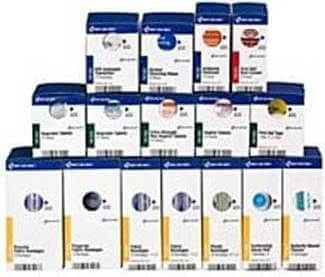
Another option is an anti-septic kit that includes a variety of anti-septics for cuts and skin conditions.
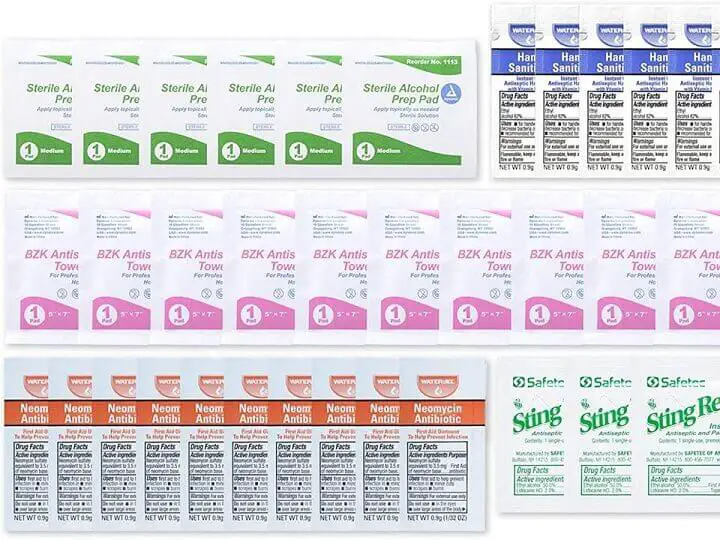
There are also OTC medications for pain, allergies, and other conditions that are simply worth buying as individual products in the bottle.
What About Prescription Pharmaceuticals
This is a complex proposition. If there are no pharmacies, there are limited alternatives. One solution is to stock up on needed pharmaceuticals with a request for a 90-day prescription. Some Canadian pharmacies will fill a prescription up to 180 days.
Other possibilities include finding natural alternatives like beet juice for high blood pressure or other natural cures like Echinacea, aloe, and a variety of other natural medicinal options.
A Medical Library
It contradicts events to think about a digital medical library following something as significant as a societal collapse. It’s fair to assume the grid will be down and the Internet as well. But the digital world can live on.
Ipads and Kindle readers can still operate and access files on their hard drives without the Internet. Recharging is possible with solar power banks, and the biggest benefit is that an entire medical library can be stored on the hard drive, making for a portable library that you always have with you.
With that in mind, here are some medical books and reference manuals in addition to some links to excellent online learning tools:
- Army Ranger Handbook
- Emergency Wound Treatment
- Survival Medical Handbook
- Survival Surgery
- The Merck Manual Home Edition
- The Physician’s Desk Reference
- U.S. Army First Aid Manual
Links to online medical information:
Apps
Numerous apps for the iPhone and Android have been developed by medical resources from the Mayo Clinic to the Red Cross. Their greatest value is their portability, especially if you are in a remote location away from home without access to books or a computer.
They cover a range of conditions from simple to significant. Some are free. The most reliable are those that are small enough to fit on your phone’s hard drive so you don’t have to depend on cellular service to access the information.
There are also articles online about a range of first aid apps tailored to specific conditions and situations.
Skills You Should Learn and Practice
Having the knowledge and ability to treat medical emergencies is more important than any collection of medical supplies and equipment. Here are some critical skills that are worth studying and practicing. Hands-on classes are best and are often offered at local fire stations, hospitals and community colleges.
Many of the links are to online, video tutorials.
- Basic wound care for cuts, scrapes, and deep wounds
- Burn treatment and continuing care
- CPR
- Diagnosis and treatments for poisoning
- Eye first aid
- Heimlich maneuver
- Heimlich on Children
- Methods to stop bleeding
- Rashes and other skin conditions
- Sprains and breaks and methods of treatment
- Suturing and practice with a suturing kit
- Unique needs of children for first aid
If you’re concerned about the threat of a collapse, now is the time to learn the skills you need to get through the worst. That obviously includes medical knowledge.
Alternative Medical Treatments
At a time where supplies, equipment, or medicines are not available, the only solution is to improvise. Some of these alternatives are fairly simple, like improvising a sling or a tourniquet. Others are scientifically proven, like the pain relief benefits of willow bark or the use of homemade, activated charcoal for poisoning.
Where things get a little complicated is when using herbal remedies as a replacement for pharmaceuticals. It’s true that some plants have natural antibiotic properties but there are many variables affecting dosage, potency, and side-effects that make the overuse or total reliance on herbal remedies a cautionary tale.
Do extensive research and due diligence, and be mindful of any cautions. In a dire emergency, it may seem like herbal remedies are the only alternative, but the critical thing is to not make things worse in a desperate effort to make things better.
- Homemade hand sanitizer
- Improvising a sling
- Improvising a splint
- Improvising a tourniquet
- Making your own activated charcoal
- Medical uses for raw honey
- Natural alternatives to bandages
- Natural immune system boosters
- Natural pain relievers
- Natural remedies for rashes and other skin conditions
Books are also an excellent reference especially across the variety of natural and herbal remedies.
- Herbal Antibiotics
- Herbal Medicine
- Herbalism for Beginners
- Modern Herbal Medicine
- Native American Herbal Remedies
Where to Start
The list we’ve covered is imposing, but as a thought starter, it’s worth considering the possibilities. The degree to which you prepare and assemble supplies and equipment will have a lot to do with your budget.
What’s important to remember is that a societal collapse will leave all of us on our own to a large degree. The key is to prioritize and slowly assemble what you can afford. Don’t forget to give special consideration to family members with specific medical needs or conditions, and don’t forget the kids. Consider child-size dosages and equipment if you have children.
Maybe the most important thing is to acquire some degree of medical knowledge for medical emergencies and consider what you would need to treat those conditions and all the ways you can improvise when supplies simply run out.
Like this post? Don't Forget to Pin It On Pinterest!


